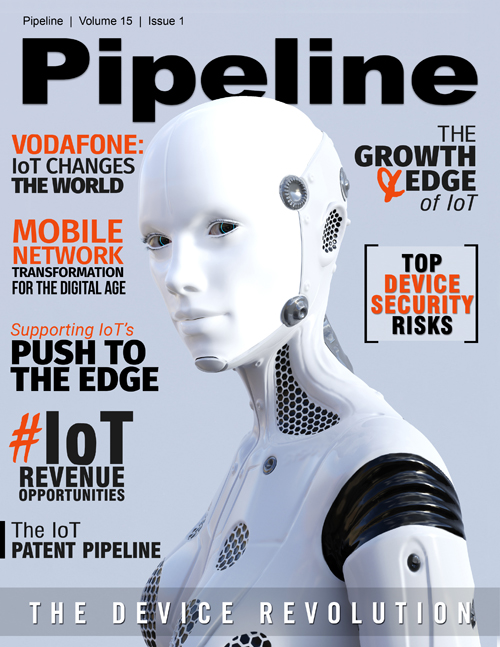By: Ludovico Fassati
The Internet of Things (IoT) is rapidly changing the way we interact with almost everything in our daily lives. From smart homes and connected cars to sensors in manufacturing plants, new
applications of IoT technology that come to market every day, making our lives easier and more efficient. All markets are integrating the technology at a breakneck pace, setting a course for
significant scale in the coming years. In fact, Gartner predicts that by 2020, IoT will connect 20.4 billion things worldwideā¦
Ā» read this article
By: Steffen Sorrell
Despite having been the subject of much discussion and investment over the past five years, the development of the Internet of Things (IoT) remains at a relatively early stage. In practice, the
reason is that, like the āclassicā Internet itself, the IoT requires not only the development of viable business models but also a transformation in the way that partaking businesses operate. That
said, those players who have already entered the market are already realizing benefits. That said, opportunity still abounds: in a survey conducted by Vodafone in 2017, 95 percent of respondents
who stated that they had adopted IoT projects also claimed to have seen tangible benefitsā¦
Ā» read this article
By: Ulrich Schalling
Significant market forces are disrupting the telecommunications industry and impacting all areas of business. To keep pace with competitors, IoT, and the rise of edge computing, network
transformation is mission critical. However, as modern networks are highly complex, this transformation has the potential to be a time-consuming and costly process. From FTTA and C-RAN architecture
upgrades to laying fiber and connecting BBU pool resources to the core network, there are countless steps that must be taken to ensure data is properly transported over mobile networks to
geographically dispersed usersā¦
Ā» read this article
By: Yossi Atias
The Internet of Things (IoT) is growing exponentially and, unless you have been hiding under a rock, itās hard not to notice the proliferation of connected devices weāre utilizing in our daily
lives. According to Gartner, as of the end of 2017, there were 6.3 billion smart devices already connected to networks, and it is predicted this number will grow to 20.4 billion by 2020. Gartnerās
estimates tend to be more conservative than others, some of whom predicted 50 billion devices by 2020. However, Gartnerās figures are collated from an installed base of smart TVs, fridges, security
cameras, speakers and other devicesā¦
Ā» read this article
By: Bob DeSantis
Weāre living in a fascinating time to watch data networks evolve. It wasnāt long ago that the industry was taken by storm by cloud computing, and nowābefore many enterprises have even begun to
leverage that modelāweāre on to the next thing, turning the cloud approach on its head with talk of edge and fog computing. In just a few years, edge has started to take holdāat least of
conversations and, increasingly, budgets. āItās really gone from a conceptual idea to something that people are working on and rolling out, trialing,ā Caroline Chan, Vice President and General
Manager of the 5G Infrastructure Division at Intel, said in this recent discussionā¦
Ā» read this article
By: Wojciech Martyniak
The Internet of Things (IoT) offers tremendous revenue opportunities for communication service providers (CSPs). Why is that, and how can CSPs seize these opportunities? First, underpinning
every data exchange between internet-enabled devices, from driverless cars to smart meters, is a whole support system that can be a source of additional revenue. CSPs run the networks that the
IoT requires to operate, so there's significant potential for the generation of additional revenue. Savvy CSPs will be poised to realize that revenueā¦
Ā» read this article
By: Alec Schibanoff
George Carlin said it best: āA house is just a place to keep your stuff while you go out and get more stuff.ā If he were around today, Carlin would say that the Internet is just a way to
connect all our stuff while we go out looking for more stuff to connect. The earliest references to an āInternet of Thingsā goes back to prehistoric timesā1999. And just as technology grows
exponentially, applications for the Internet of Things or IoT have grown exponentially as well. Both Loweās and The Home Depot have smart home sectionsājust one outgrowth of IoTāand they are both
right up in the front of the store, not in the back with the plumbing and carpetingā¦
Ā» read this article
By: Scott St. John - Pipeline
Smart cities, smart sprinklers, and smart cars: July brought news of fascinating developments in and applications for IoT technology. And thatās even before the new Nokia Open Innovation
Challenge global competition truly gets underway. This new annual competition puts Nokia prize money behind innovative technology, products, and solutions that will change the world, and this
year's focus is on IoT. The news this month also included broadband internet expansion to previously unserved areas of the Northeast Uā¦
Ā» read this article
By: Scott St. John - Pipeline
As Pipeline enters its 15th volume, it causes me take pause. Over the last 15 years, we've seenāand coveredāa lot of topics. We have had the privilege to watch the world change.
Dramatically.During this time we saw the advent of IP-based services, smart phones, social media, tablets, cloud computing, and the internet of things (IoT). Just to name a few. We've been on the
forefront of worldwide transformation, and have foreseen everything from Microsoft 365 to the NSA leak.Today, we are standing on the precipice of even greater changeā¦
Ā» read this article

















